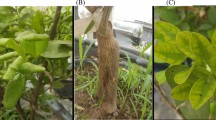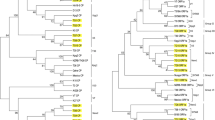Abstract
Background
Citrus plants are prone to infection by different viroids which deteriorate their vigor and production. Citrus viroid V (CVd-V) is among the six citrus viroids, belongs to genus Apscaviroid (family Pospiviroidae) which induces symptoms of mild necrotic lesions on branches and cracks on trunk portion.
Methods and results
A survey was conducted to evaluate the prevalence of CVd-V in core and non-core citrus cultivated areas of Punjab, Pakistan. A total of 154 samples from different citrus cultivars were tested for CVd-V infection by RT-PCR. The results revealed 66.66% disease incidence of CVd-V. Citrus cultivars Palestinia Sweet lime, Roy Ruby, Olinda Valencia, Kaghzi lime, and Dancy were identified as new citrus hosts of CVd-V for the first time from Pakistan. The viroid infection was confirmed by biological indexing on indicator host Etrog citron. The reported primers used for the detection of CVd-V did not amplify, rather showed non-specific amplification, which led to the designing of new primers. Whereas, new back-to-back designed primers (CVd-V AF1/CVd-V AR1) detected CVd-V successfully and obtained an expected amplified product of CVd-V with 294 bp. Sequencing analysis confirmed the new host of CVd-V showing 98–100% nucleotide sequence homology with those reported previously from other countries while 100% sequence homology to the isolates reported from Pakistan. Based on phylogenetic analysis using all CVd-V sequences in GenBank, two main CVd-V groups (I and II) were identified, and newly identified isolates during this study fall in the group I.
Conclusion
The study revealed that there are some changes in the nucleotide sequences of CVd-V which made difficult for their detection using reported primers. All isolates of Pakistan showed high sequence homology with other isolates of CVd-V from Iran and USA whereas; the isolates from China, Japan, Tunisia, and Africa are distantly related. It is evident that CVd-V is spreading in all citrus cultivars in Pakistan.




Similar content being viewed by others
Data availability
All data needed to conduct this study is provided within the manuscript and RNA-Seq reads have been submitted to the NCBI database under accession number given in manuscript.
References
Naqvi SA, Atta S, Liu H, Rehman AU, Khan AA (2017) Serological and molecular based detection of graft-transmissible pathogens associated with citrus from non-core areas of Pakistan. Pak J Agric Sci 54(4):793–799
Memon NA (2017). Citrus fruit (Kino): Punjab produced 98% of production. Exclusive on Kino. Pak J Food 2017(Jan-Feb): 29–31.
Flores R, Minoia S, Carbonell A, Gisel A, Delgado S, López-Carrasco A, Navarro B, Di Serio F (2015) Viroids, the simplest RNA replicons: how they manipulate their hosts for being propagated and how their hosts react for containing the infection. Virus Res 209:136–145
Ebrahimi-Moghadam L, Zakiaghl M, Jafarpour B, Mehrvar M (2017) Construction of infectious clones and demonstration of pathogenicity of citrus viroids. Iran J Plant Pathol 53(4):399–415
Hadidi A (2019) Next-generation sequencing and CRISPR/Cas13 editing in viroid research and molecular diagnostics. Viruses 11(2):120
Chambers GA, Geering AD, Holford P, Vidalakis G, Donovan NJ (2022) Development of a one-step RT-qPCR detection assay for the newly described Citrus viroid VII. J Virol Methods 299:114330
Gobatto D, Chaves AL, Harakava R, Marque JM, Daròs JA, Eiras M (2014) Chrysanthemum stunt viroid in Brazil: survey, identification, biological and molecular characterization and detection methods. Plant Pathol 96(1):111–119
Matsushita Y, Yanagisawa H, Sano T (2018) Vertical and horizontal transmission of Pospiviroids. Viruses 10(12):706
Katsarou K, Chiumenti M, Kalantidis K, Mathioudakis MM (2020) First report of citrus viroids infecting Persian (Tahiti) lime in Greece. Plant Dis 104(3):998
Hamdi I, Elleuch A, Bessaies N, Fakhfakh H (2011) Insights on genetic diversity and phylogenetic analysis of Hop stunt viroid (HSVd) population from symptomatic citrus tree in Tunisia. Afr J Microbiol Res 5(21):3422–3431
Ito T, Ieki H, Ozaki K, Ito T (2001) Characterization of a new citrus viroid species tentatively termed Citrus viroid OS. Arch Virol 146(5):975–982
Serra P, Barbosa CJ, Daròs JA, Flores R, Duran-Vila N (2008) Citrus viroid V: molecular characterization and synergistic interactions with other members of the genus Apscaviroid. Virology 370(1):102–112
Elleuch A, Hamdi I, Bessaies N, Fakhfakh H (2013) Single-strand conformation polymorphism for molecular variability studies of six viroid species. Biosci Biotechnol Biochem 77(1):182–188
Keese P, Symons RH (1985) Domains in viroids: evidence of intermolecular RNA rearrangements and their contribution to viroid evolution. Proc Natl Acad Sci USA 82(14):4582–4586
Giguere T, Perreault JP (2017) Classification of the Pospiviroidae based on their structural hallmarks. Pone 12(8):e0182536
Najar A, Hamdi I, Ben Mahmoud K (2018) Citrus viroids: characterization, prevalence, distribution and struggle methods. J New Sci 50:3129–3137
Chambers GA, Bogema DR, Englezou A, Donovan NJ (2020) First report of Citrus viroid V and Citrus viroid VI in Australia infecting citrus. Plant Dis 104(7):2037
Vernière C, Perrier X, Dubois C, Dubois A, Botella L, Chabrier C, Bové JM, Vila ND (2004) Citrus viroids: symptom expression and effect on vegetative growth and yield of clementine trees grafted on trifoliate orange. Plant Dis 88(11):1189–1197
Tessitori M (2017) Apscaviroids infecting citrus trees. In: Ahmed H, Ricardo F, John WR, Peter P (eds) Viroids and satellites. Academic Press, London, pp 243–249
Cao M, Atta S, Su H, Wang X, Wu Q, Li Z, Zhou C (2013) Molecular characterization and phylogenetic analysis of Citrus viroid V isolates from Pakistan. Eur J Plant Pathol 135(1):11–21
Barbosa CJ, Pina JA, Pérez-Panadés J, Bernad L, Serra P, Navarro L, Duran-Vila N (2005) Mechanical transmission of citrus viroids. Plant Dis 89(7):749–754
Hamdi I, Elleuch A, Bessaies N, Grubb CD, Fakhfakh H (2015) First report of Citrus viroid V in North Africa. J Gen Plant Pathol 81(1):87–91
Serra P, Pina JA, Durán-Vila N (2010). Identification and characterization of a variant of Citrus viroid V (CVd-V) in Seminole tangelo. In: Seventeenth conference of the international organization of citrus virologists (IOCV). pp 150–157
Hashemian SB, Taheri H, Alian YM, Bové JM, Durán-Vila N (2013) Complex mixtures of viroids identified in the two main citrus growing areas of Iran. Plant Pathol 1:647–654
Hashemian SB, Serra P, Barbosa CJ, Juárez J, Aleza P, Corvera JM, Lluch A, Pina JA, Durán-Vila N (2009) Effect of a field-source mixture of citrus viroids on the performance of ‘Nules’ Clementine and ‘Navelina’ sweet orange trees grafted on Carrizo Citrange. Plant Dis 93(7):699–707
Önelge N, Yurtmen M (2012) First report of Citrus viroid V in Turkey. Plant Pathol 94(4):1–2
Dang T, Tan SH, Bodaghi S, Greer G, Lavagi I, Osman F, Ramirez B, Kress J, Goodson T, Weber K, Zhang YP (2018) First report of Citrus viroid V naturally infecting grapefruit and calamondin trees in California. Plant Dis 102(10):2050
Yaqub MS, Khan IA, Usman M, Rana IA (2017) Molecular detection of Candidatus Liberibacter asiaticus, the causal organism of huanglongbing (Citrus greening) in Faisalabad, Pakistan for huanglongbing management. Pak J Agric Sci 54(1):21–26
Zhou C, da Graça JV, Freitas-Astua J, Vidalakis G, Durán-Vila N, Lavagi I (2020) Citrus viruses and viroids. In: Manuel T, Marco C, Fred G (eds) The genus citrus. Wood head Publishing, Duxford, pp 391–410
Roistacher CN (1991) Graft-transmissible diseases of citrus: handbook for detection and diagnosis. FAO Public Division, Rome, p 286
Steyn C, Cook G, Burger JT, Maree HJ (2016) Construction and application of infectious citrus viroids for biological indexing. J Cit Pathol 3(1):1–7
Fiore N, Zamorano A, Pino AM, González F, Rosales IM, Sánchez-Navarro JA, Pallás V (2016) Survey of stone fruit viruses and viroids in Chile. Plant Pathol 1:631–635
Altschul SF, Madden TL, Schäffer AA, Zhang J, Zhang Z, Miller W, Lipman DJ (1997) Gapped BLAST and PSI-BLAST: a new generation of protein database search programs. Nucleic Acids Res 25(17):3389–3402
Tamura K, Peterson D, Peterson N, Stecher G, Nei M, Kumar S (2011) MEGA5: molecular evolutionary genetics analysis using maximum likelihood, evolutionary distance, and maximum parsimony methods. Mol Biol Evol 28(10):2731–2739
Tamura MN, Fuse S, Azuma H, Hasebe M (2004) Biosystematic studies on the family Tofieldiaceae I. Phylogeny and circumscription of the family inferred from DNA sequences of matK and rbcL. Plant Biol 6(05):562–567
Cao MJ, Atta S, Liu YQ, Wang XF, Zhou CY, Mustafa A, Iftikhar Y (2009) First report of citrus bent leaf viroid and citrus dwarfing viroid from citrus in Punjab, Pakistan. Plant Dis 93(8):840–840
Vernière C, Perrier X, Dubois C, Dubois A, Botella L, Chabrier C, Bové JM, Vila ND (2006) Interactions between citrus viroids affect symptom expression and field performance of clementine trees grafted on trifoliate orange. Phytopathology 96(4):356–368
Ito T, Ohta S (2010) First report of Citrus viroid V in Japan. J Gen Plant Pathol 76(5):348–350
Acknowledgements
Authors thanks to the Deanship of Scientific Research, King Khalid University, Saudi Arabia for funding this work under Grant No. (RGP. 2/90/43).
Funding
The research work was partially funded by King Khalid University, Saudi Arabia under the Grant No. (RGP. 2/90/43).
Author information
Authors and Affiliations
Contributions
Methodology: AA, UU and AR; software: UU, MTS, MNT and S Atta; validation: UU, SA, AR, FÖ and RP; formal analysis: AA and UU; investigation: UU, AR and RP; data curation: UU, MTS, MM and MNT; writing—original draft preparation: AA; writing—review and editing: UU, MNT, S Atta, SA, MM and FÖ; visualization: UU, AR, RP, MM and MNT; supervision: UU and AR. All authors have read and agreed to the published version of the manuscript.
Corresponding authors
Ethics declarations
Conflict of interest
The authors confirm that this article content has no conflict of interest.
Ethical approval
All authors read the study and showed their willingness to publish this study. This manuscript does not contain any research activity involving the animals or human participants performed by any of the authors.
Consent to participate and publish
The author read the manuscript and showed his willingness to publish this study.
Additional information
Publisher's Note
Springer Nature remains neutral with regard to jurisdictional claims in published maps and institutional affiliations.
Supplementary Information
Below is the link to the electronic supplementary material.
Rights and permissions
About this article
Cite this article
Ali, A., Umar, U., Akhtar, S. et al. Identification and primary distribution of Citrus viroid V in citrus in Punjab, Pakistan. Mol Biol Rep 49, 11433–11441 (2022). https://doi.org/10.1007/s11033-022-07677-7
Received:
Accepted:
Published:
Issue Date:
DOI: https://doi.org/10.1007/s11033-022-07677-7




